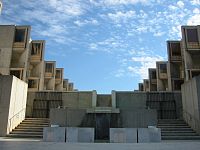| Revision as of 04:14, 22 September 2005 edit66.75.232.84 (talk)No edit summary← Previous edit | Revision as of 03:51, 23 September 2005 edit undoCurpsbot-unicodify (talk | contribs)29,655 editsm 3 link(s): + → Next edit → | ||
| Line 1: | Line 1: | ||
| ]]The '''Salk Institute for Biological Studies''' is an independent non-profit educational research organization in ]. It was founded in ] by ], M.D., the developer of the polio vaccine. Among the founding consultants were ] and ]. The institute has 56 labs and focuses its research in three areas: ] and ]; ]s; and ] Biology. Research topics include ], ], birth defects, ], ], ], and plant biology. The ] provided the initial funding and continues to support the institute to this day. The campus was designed by the renowned architect ]. Salk had sought to make a beautiful campus in order to draw the best researchers in the world. The original buildings of the Salk Institute were designated as a historical landmark in 1991. | ]]The '''Salk Institute for Biological Studies''' is an independent non-profit educational research organization in ]. It was founded in ] by ], M.D., the developer of the polio vaccine. Among the founding consultants were ] and ]. The institute has 56 labs and focuses its research in three areas: ] and ]; ]s; and ] Biology. Research topics include ], ], birth defects, ], ], ], and plant biology. The ] provided the initial funding and continues to support the institute to this day. The campus was designed by the renowned architect ]. Salk had sought to make a beautiful campus in order to draw the best researchers in the world. The original buildings of the Salk Institute were designated as a historical landmark in 1991. | ||
| The Salk Institute currently employs more than 1200 preeminient faculty, researchers and staff. | The Salk Institute currently employs more than 1200 preeminient faculty, researchers and staff. | ||
| Line 5: | Line 5: | ||
| ==History== | ==History== | ||
| Salk and Kahn approached the city of ] in March of 1960 about a gift of land on the ] and were granted their request after a ] passed in June 1960. Construction began in 1962 and a handful of researchers moved into the first labratory in 1963. | Salk and Kahn approached the city of ] in March of 1960 about a gift of land on the ] and were granted their request after a ] passed in June 1960. Construction began in 1962 and a handful of researchers moved into the first labratory in 1963. | ||
| Jonas Salk died in 1995. A memorial lies at the entrance to the Institute and captures his vision: "Hope lies in dreams, in imagination and in the courage of those who dare to make dreams into reality." | Jonas Salk died in 1995. A memorial lies at the entrance to the Institute and captures his vision: "Hope lies in dreams, in imagination and in the courage of those who dare to make dreams into reality." | ||
Revision as of 03:51, 23 September 2005


The Salk Institute for Biological Studies is an independent non-profit educational research organization in La Jolla, California. It was founded in 1960 by Jonas Salk, M.D., the developer of the polio vaccine. Among the founding consultants were Jacob Bronowski and Francis Crick. The institute has 56 labs and focuses its research in three areas: Molecular Biology and Genetics; Neurosciences; and Plant Biology. Research topics include cancer, diabetes, birth defects, Alzheimer's Disease, Parkinson's Disease, AIDS, and plant biology. The March of Dimes provided the initial funding and continues to support the institute to this day. The campus was designed by the renowned architect Louis Kahn. Salk had sought to make a beautiful campus in order to draw the best researchers in the world. The original buildings of the Salk Institute were designated as a historical landmark in 1991.
The Salk Institute currently employs more than 1200 preeminient faculty, researchers and staff.
History
Salk and Kahn approached the city of San Diego in March of 1960 about a gift of land on the Torrey Pines Mesa and were granted their request after a referendum passed in June 1960. Construction began in 1962 and a handful of researchers moved into the first labratory in 1963.
Jonas Salk died in 1995. A memorial lies at the entrance to the Institute and captures his vision: "Hope lies in dreams, in imagination and in the courage of those who dare to make dreams into reality."
Notable faculty
Salk faculty have received a total of five Nobel Prizes. Three of the institute's resident faculty members are Nobel laureates.
As of 2003, 13 of the Salk's faculty were members of the National Academy of Sciences.
Architecture
The Salk Institue's campus represents a blend of form and function. Each of the laboratories is built to be spacious, open to ambient lighting, and is completely reconfigurable to meet the changing needs of science. In 1992, the Salk received a 25 Year Award from the American Institute of Architects, and is recognized as the single most significant architectural site in San Diego.